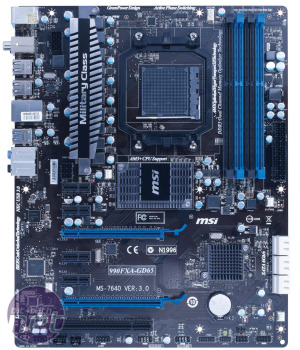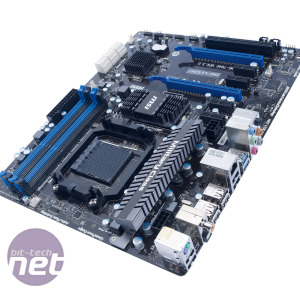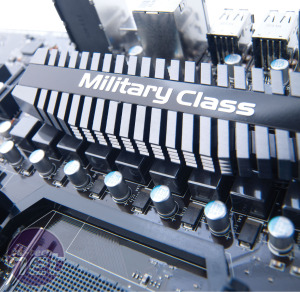What's the Best AMD Bulldozer Motherboard?
November 22, 2011 | 07:59

MSI 990FXA-GD65 Review
Manufacturer: MSIUK price (as reviewed): £107.99 (inc VAT)
US price (as reviewed): $153.99 (ex tax)
MSI’s 990FXA-GD65 is the only board in this group test that we haven’t previously tested, but we were keen to see if a sub-£110 board could trade blows with the more expensive boards on test. It has a fairly unremarkable PCB that’s unlikely to make you look twice. There are just two 16x PCI-E slots, although it supports both SLI and CrossFireX. The two slots are also spaced well apart for cooling your GPUs, but note that the lower slot has only 8x PCI-E lanes.
In addition to a single PCI slot, there are also four 1x PCI-E slots – quite why you’d need four of these is beyond us but, again, these are well positioned above and below the primary PCI-E slot. Layout is good on the whole, thanks to the fairly spartan PCB – there are no on-board power or reset switches, and only six SATA 6Gbps ports too.
At stock speed, the 990FXA-GD65 didn’t exactly rise above the rest – its overall Media Benchmarks score of 1,518 and minimum frame rate in Arma II of 58fps were within a smidgen of the competition. This is a good result for a budget board, however, especially when you consider that its Media Benchmark score was only 3 per cent behind that of the significantly more expensive Crosshair V Formula.
After updating the EFI we were presented with a new slick and snazzy interface, although it exhibited quite a bit of lag, which sometimes had us trying to remember whether or not we’d actually just used the keyboard.
MSI’s OC Genie II automatic overclocking system also makes an appearance, and made it easy enough to generate for small to medium overclocks; we would boost the HTT, and the board would do the rest.
However, when pushed too far, the board would fail to recover without clearing the CMOS, which is a royal pain in the rear. When we switched to full manual overclocking, this issue became even more frustrating, as the 990FXA-GD65 proved to be particularly sensitive and unforgiving, with a single notch in some settings deciding the difference between win or epic fail.
Having reset the CMOS for the umpteenth time, we started saving each overclocking endeavour to a profile and loading this if the worst should happen, which it often did. In the end, we reached an HTT of 260MHz. However, we had to drop this to 240MHz when aiming for the highest CPU frequency. Combined with a CPU multiplier of 20x, this resulted in a healthy overclock of 4.8GHz – practically the same as the Crosshair V Formula.
This was achieved using voltages of 1.456V for the vcore, 1.304V for the CPU NB and 1.314V for the NB. Meanwhile, the RAM ran at 1,600MHz with a voltage of 1.65V. This saw the overall Media Benchmarks score rise to 1,826 and the minimum frame rate gain 10fps at 68fps – slightly behind the results of the Crosshair V.
Conclusion
The 990FXA-GD65 is a mixed bag of a motherboard; on the one hand, it holds its own with the more expensive boards on test, especially if you’re going for high CPU overclocks. Its EFI is laggy, but was generally easy to use, although not quite as streamlined as Asus’ effort. It was, however, a frustrating and time-consuming motherboard to overclock and despite its bargain-tastic sub-£110 price tag, the Sabertooth is the better option if you wish to go beyond stock clock speeds, even if it costs that much more.
Specifications
- Chipset AMD 990FX
- CPU support Socket AM3+ Athlon II, Phenom II, Sempron 100-series, future Socket AM3+ CPUs
- Memory support 4 slots: max 32GB DDR3
- Expansion slots two 16x PCI-E 2 slots (one 16x, one 8x), four 1x PCI-E, one PCI
- Sound 8-channel HD Audio via Realtek ALC882
- Networking Realtek RTL8111E Gigabit Ethernet
- Overclocking HTT frequency 190– 600MHz; max voltages, CPU 1.974V, CPU NB 1.84V, chipset 1.4V, RAM 2.46V
- Ports 4 x SATA 6Gbps, PS/2, 10 x USB 2, 4 x USB 3, LAN, 4 x surround audio out, line in, mic, optical S/PDIF out
- Dimensions (mm) 305 x 244 (ATX)

MSI MPG Velox 100R Chassis Review
October 14 2021 | 15:04











Want to comment? Please log in.